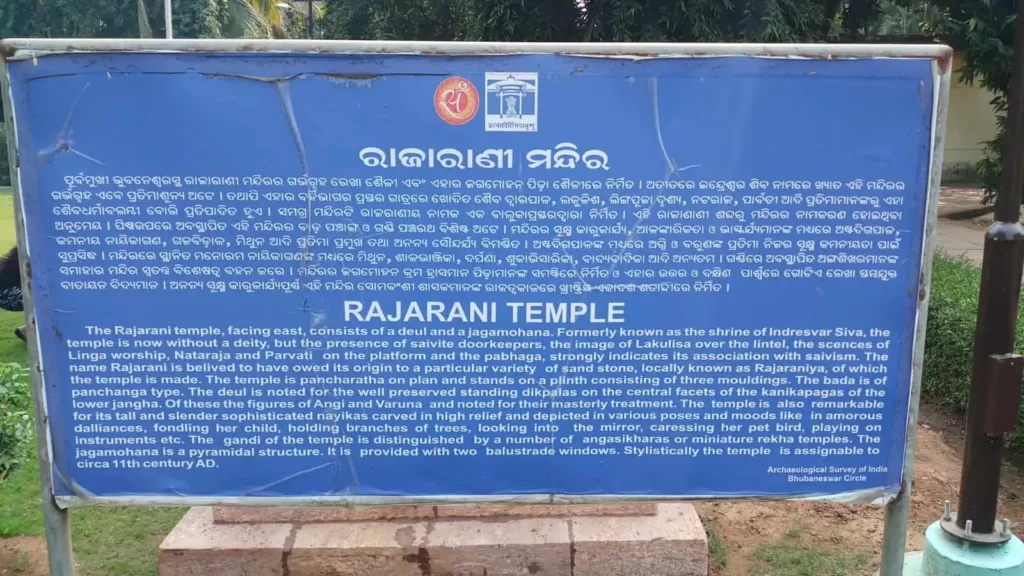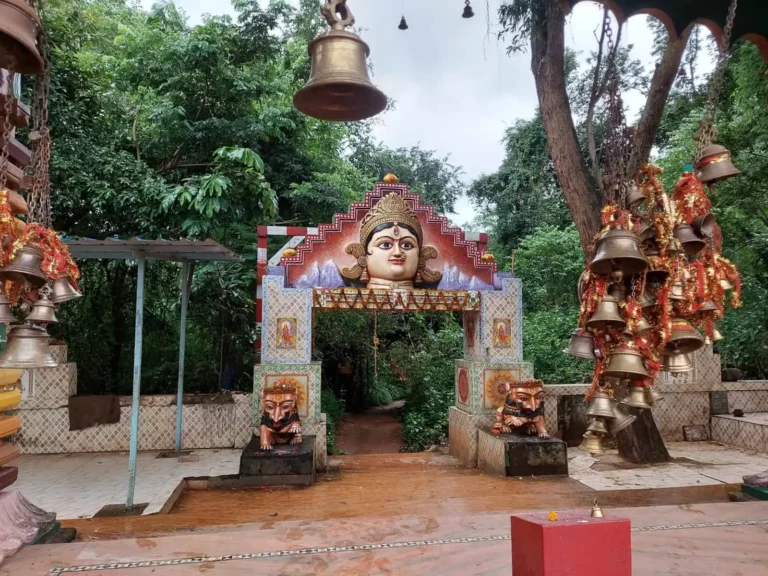Raja Rani Temple Bhubaneswar – Timings, History, Entry Fee, Images, Aarti, Location
Welcome to the world-renowned Raja Rani Temple in Bhubaneswar, a majestic architectural masterpiece that stands as a testament to the rich heritage and cultural legacy of Odisha. This ancient temple, also known as the “Love Temple,” is renowned for its exquisite carvings and intricate sculptures that depict various deities and mythological figures. In this article, we will take you through the fascinating history of the Raja Rani Temple, its timings, entry fee, and location. We will also provide you with stunning images of the temple’s captivating beauty and share insights into the daily aarti performed here.

The Raja Rani Temple is an iconic landmark of Bhubaneswar. This beautiful temple is famous for its exquisite architecture and intricate carvings. Built during the 11th century, the temple is dedicated to Lord Shiva and is one of the most visited temples in the state.
In this comprehensive guide, we will delve into the history, architecture, and significance of the Raja Rani Temple. We will also provide you with all the necessary information you need to know before visiting the temple.
Raja Rani Temple Timings
| Day | Timing |
|---|---|
| Monday | 6:30 am – 7:30 pm |
| Tuesday | 6:30 am – 7:30 pm |
| Wednesday | 6:30 am – 7:30 pm |
| Thursday | 6:30 am – 7:30 pm |
| Friday | 6:30 am – 7:30 pm |
| Saturday | 6:30 am – 7:30 pm |
| Sunday | 6:30 am – 7:30 pm |
Raja Rani Temple Bhubaneswar Address: Tankapani Rd, Near BOI ATM, Rajarani Colony, Bhubaneswar, Odisha, 751002
Google map link of Raja Rani Temple
Raja Rani Temple Entry Fee and Tickets
| Visitor Category | Entry Fee |
|---|---|
| Indian | Rs. 5 |
| Foreign | Rs. 250 |
| Children (<15) | Free |
History of Raja Rani Temple
The Rajarani Temple has a rich history dating back to the 11th century when it was constructed by Indraratha, a renowned ruler of the Somavamsi dynasty. Historians suggest that the temple was originally named Indreswara after Indraratha, but some believe it was named after Lord Shiva. The temple is associated with Shaivism, despite having no presiding deity.
Over time, the temple earned the name Rajarani due to the yellow and red sandstone used in its construction, which is locally known as Rajarani. In 1903, the temple underwent a major renovation to restore it to its former glory as it had fallen into disrepair. Today, the Archaeological Survey of India maintains the temple.
The Government of Odisha’s Department of Tourism hosts the Rajarani Music Festival on the temple grounds every January-February. This three-day cultural extravaganza celebrates Indian classical music, including Hindustani, Odissi, and Carnatic. Musicians from across the country participate in this festival, which attracts a large number of visitors. The festival was first organized in 2003 in partnership with the Bhubaneswar Music Circle.
Visiting Bhubaneswar? Consider reading: Best places to visit in Bhubaneswar
Raja Rani Temple Bhubaneswar Photos and Images
The Architecture of Raja Rani Temple
The Rajarani Temple showcases a stunning example of Kalinga-style temple architecture. The shrine is constructed on a three-moulded platform in Pancharatha style and is divided into two sections: the Jagamohana, where devotees can witness the sanctum, and the Vimana, which houses the inner sanctum. The Jagamohana has a pyramidal-shaped roof, while the Vimana has a magnificent curvilinear spire (Shikhara) that reaches up to 17.9 meters.
At the top of the Jagamohana entrance, an image of a lion guards the door, and on the entrance, there are sculptures of Naga and Nagin, believed to represent the king and queen of that time. Above the entrance door, the Navagraha (nine planets) is sculpted, and just below it, there is an image of Lakulisa, the founder of Shaivism. On both sides of the entrance door, you can see carvings of two small Shaiva doorkeepers named Chanda and Prachanda.
The walls of the shrine boast beautiful engravings depicting the marriage of Lord Shiva and Goddess Parvati, confirming that this temple is dedicated to Lord Shiva. One of the most fascinating features of the temple is the sculptures protruding in eight directions from its base.
These sculptures depict Kubera (God of Wealth), Yama (God of Death), Vayu (God of Wind), Indra (God of Rain), Agni (God of Fire), Nirriti (God of Suffering), Varuna (God of Ocean), and Ishana (Shiva). They are believed to be the protectors of this ancient Hindu temple.
Interested to visit temples in Bhubaneswar? Consider visiting: Lingaraj temple
Significance of Raja Rani Temple
The Raja Rani Temple is not dedicated to a specific deity, but it holds immense cultural and historical significance. The temple is believed to have been a place of worship for the royal family of the Somavamsi dynasty.
The temple is also famous for its unique architectural style and exquisite carvings, which are a testament to the skilled craftsmanship of the artisans of the time. The temple is a popular tourist attraction and is visited by thousands of people every year.
How to reach Raja Rani Temple
The Rajarani Temple is situated in a prime location in Bhubaneswar and can be conveniently accessed from various parts of the city, including the railway station, bus stand, and airport. The temple is easily accessible by local buses, private taxis, and auto rickshaws, making commuting a hassle-free experience.
The temple is approximately 4 km away from the Biju Patnaik International Airport, and it takes only 11 minutes to reach the shrine by taxi or auto rickshaw. The distance between the temple and the Bhubaneswar railway station is around 3.9 km, and it takes about 10 minutes to reach the temple by availing of an autorickshaw or taxi service. Local buses are also available and take approximately 30-35 minutes to reach the temple from the railway station.
Another peaceful temple you can consider visiting: ISKCON Temple Bhubaneswar
Things to do at the Raja Rani Temple
The Rajarani Temple in Bhubaneswar is a beautiful and historic shrine that is worth visiting. Here are some things to do when you visit the temple:
- Admire the Architecture: The Rajarani Temple is known for its beautiful Kalinga-style architecture. Take some time to admire the intricate carvings and sculptures on the walls and doors of the temple.
- Attend the Rajarani Music Festival: If you happen to visit the temple in the month of January-February, you can attend the Rajarani Music Festival that is held here. The festival features some of the best classical musicians from across the country and is a treat for music lovers.
- Learn about the history: The temple has a rich history that dates back to the 11th century. You can learn more about the temple’s history and its connection to Shaivism by talking to the local guides or reading up on the subject.
- Take photographs: The temple is a popular spot for photography enthusiasts. You can capture the beautiful carvings, sculptures and architecture of the temple in your camera.
- Enjoy a peaceful time: The temple is a peaceful and serene place, perfect for introspection and meditation. Take some time to sit and relax, enjoying the tranquillity of the surroundings.
Wondering what to see in Bhubaneswar? Consider: Udayagiri and Khandagiri Caves
FAQs on Raja Rani Temple Bhubaneswar
What is the history of the Raja Rani Temple in Bhubaneswar?
The Raja Rani Temple was built in the 11th century by Indravarman, a Somavamshi king, in the Kalinga style of architecture. The temple was later named Raja Rani because of the local name of the yellow and red sandstone used in its construction.
What is the significance of the Raja Rani Temple?
The Raja Rani Temple is an important historical and cultural landmark in Bhubaneswar. It is considered to be one of the finest examples of Kalinga architecture and is known for its intricate carvings and sculptures. The temple is also associated with Shaivism, one of the major branches of Hinduism.
What are the timings of the Raja Rani Temple in Bhubaneswar?
The Raja Rani Temple is open to the public from 6:30 am to 7:30 pm every day of the week.
What is the entry fee for the Raja Rani Temple?
The entry fee for the Raja Rani Temple is Rs. 5 for Indian visitors and Rs. 250 for foreign visitors. Children below 15 years of age are not charged an entry fee.
What is the best time to visit the Raja Rani Temple?
The best time to visit the Raja Rani Temple is between October and March when the weather is pleasant and the temperatures are moderate.
How can I reach the Raja Rani Temple in Bhubaneswar?
The Raja Rani Temple is located in a prime location of Bhubaneswar and can be easily reached from the railway station, bus stand, airport, and other parts of the city. Commuting to the temple is quite easy as there is regular availability of local buses, private taxis, and auto-rickshaws in Bhubaneswar.
Are there any festivals celebrated at the Raja Rani Temple?
Yes, the Raja Rani Temple is the venue for the annual Rajarani Music Festival, which is held in the month of January-February. The festival features classical music performances by musicians from all over India.
Can visitors take photographs inside the Raja Rani Temple?
Yes, visitors are allowed to take photographs inside the Raja Rani Temple, but they are not allowed to use flash photography or tripods.










